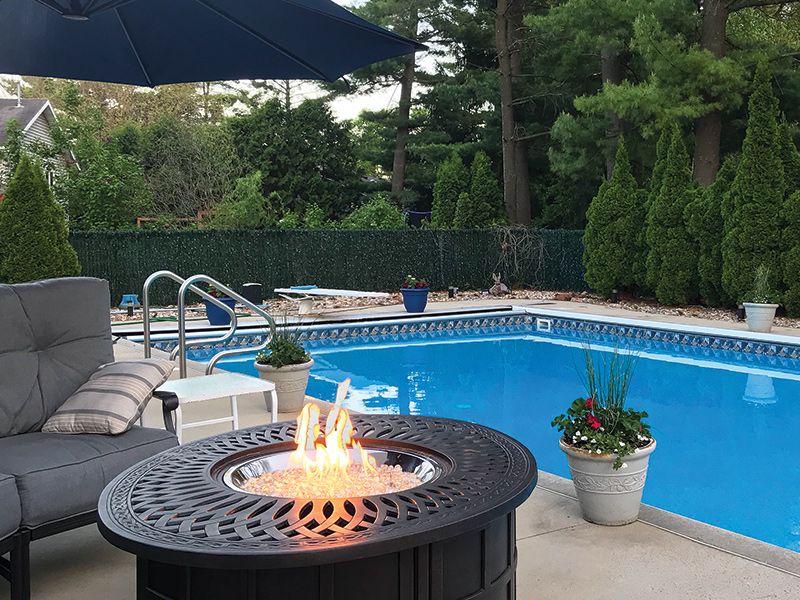Options and advice to keep your grill tanks ready for action!
If the past year is any indication, something tells us that entertaining at home is not just a passing fad. Maybe you’ve really upped your grilling game, added a fire pit for family and close friends to gather around, or installed heat lamps for anytime dining on the patio. Whatever the choice, outdoor living is year round, and it’s here to stay.
There’s just one thing you really need to keep on top of: your propane supply. The last thing you want is to cozy up in front of the flame and watch it sputter out. Fortunately, you have options for keeping your propane tank filled. Be prepared with this cheat sheet on the pros and cons of refilling versus exchanging your propane tank. It’ll help you know when, where, and how to get a fresh tank -- plus tips on making the most of your outdoor propane appliances.
Option 1: Refill the cylinder. If you don’t have a fuel gauge on the collar of your propane tank, one reliable way to tell if you're running low is to observe the flames it’s producing. If your grill or heat lamp has a sputtering flame or is just not generating enough heat, that’s often a signal that the tank is low. It’s also a good idea to keep track of how often you run out of propane and then build refills into your household routine -- you’re less likely to be stuck without propane.
Another way to monitor the tank level is to simply pick it up. (A standard grill tank filled to standard capacity -- about 15 pounds’ worth of liquid propane -- should weigh about 32 pounds. That’s about the same as an average 4-year-old.) If it feels light, it’s probably time to have fuel added to the tank.
Another tip: Keep a spare propane tank on hand; that way you can easily rotate in a fresh tank whenever you need to and refill later. This is especially useful if you don’t have a fuel gauge, since it can be tough to estimate tank levels.
Pros: You’ll probably save some money. The price of propane refill and exchange services vary widely regionally and over time, but in general refilling your tank is the most cost-effective option, given the added costs of exchange such as tank inventory and retailer markups.
Cons: You’re responsible for monitoring the tank, keeping it in usable condition, and having it recertified on the schedule indicated on the cylinder . And there may be fewer propane refill locations than there are exchange locations (check our locator for options). Plus, refilling takes a little time, especially compared with a grill tank exchange, which is essentially grab and go.
Option 2: Exchange your propane tank. Unhook your spent cylinder. Take it to your neighborhood supermarket or convenience store. Walk out with a fresh cylinder. What could be easier? Over the years, we’ve added many propane exchange locations, so you always have access to safe, convenient propane exchanges near you.
Pros: Next to seeing your personal propane supply delivered to your door (we can arrange that), it’s the most convenient way to refill your propane.
Cons: As noted above, it can be a little more expensive to exchange versus refill your propane tank. This is because, in addition to the propane itself, the cost also includes things like the replacement cylinder, recycling or refurbishing your old one, and retailer costs.
Option 3: Think about getting a bigger cylinder. If you’ve invested in, say, a professional-grade grill that you keep in heavy rotation, and you have the space, you could swap out your standard grill tank for a larger option such as 40 lb or even 100 lb (contact AmeriGas for advice and pricing on the best tank sizes for your situation).
Pros: Fewer trips to the store for a propane refill or tank exchange. A larger tank may be a good choice if you’re using it in cold weather. Since propane’s vaporization rate is much higher in a larger tank than in a smaller one in general, and propane vaporizes more slowly as the temperature drops , a tank that will burn strong when the temp drops to zero might give you added peace of mind.
Cons: There’s some set-up cost: In addition to purchasing the tank itself, you’ll also need to secure it in a safe spot and install adapters to connect the tank since the cabinetry of most outdoor appliances such as fire pits and heat towers are designed specifically to accommodate smaller tanks. Not all retailers offer larger cylinders for exchange, and you have to make sure you can transport the tank safely for refilling (or arrange for delivery).
No matter the size or number of propane tanks you select for your outdoor entertaining needs, remember that just a little planning can keep your marshmallows toasting and burgers grilling … all year long.
Find out how to use propane for safe, convenient outdoor entertaining.
Related articles:
The Benefits of Cylinder Refill
What’s the Difference Between Propane Refill and Propane Exchange?
How to Buy, Exchange, or Dispose of a Propane Tank
Propane Tanks Go to blog list page filtered for the category

